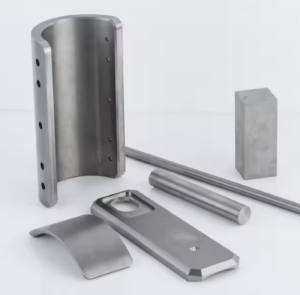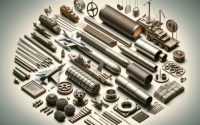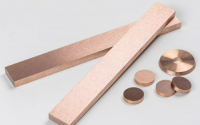3 Most Common Types of Tungsten Alloys
Introduction
Tungsten alloys are known for their exceptional properties, making them indispensable in various high-performance applications. Among the numerous tungsten alloys, Tungsten-Copper (WCu), Tungsten-Silver (WAg), and Tungsten Heavy Alloys (WHA) stand out. This article will discuss their properties, applications, and benefits.

1. Tungsten-Copper (WCu) Alloy
Composition and Properties:
Tungsten-Copper (WCu) alloys are typically composed of a mixture of tungsten (W) and copper (Cu), combining the desirable properties of both metals. Tungsten contributes high melting points, density, and strength, while copper adds excellent electrical and thermal conductivity.
The most notable properties of WCu alloys include:
- High Thermal Conductivity: The copper content ensures that WCu alloys have excellent thermal conductivity, making them ideal for heat dissipation applications.
- Electrical Conductivity: Copper’s presence also provides good electrical conductivity, crucial for electrical contacts and electrodes.
- High Melting Point: Tungsten’s high melting point allows WCu alloys to perform well in high-temperature environments.
- Strength and Durability: These alloys maintain significant mechanical strength and resistance to wear, even under extreme conditions.
Applications:
Due to these properties, WCu alloys are commonly used in:
– Electrical Contacts and Electrodes: Their electrical and thermal conductivity makes them suitable for electrical discharge machining (EDM) and welding applications.
– Heat Sinks: WCu alloys are often used in electronics to dissipate heat efficiently, protecting sensitive components from thermal damage.
– Aerospace Components: Their high strength and heat resistance make them suitable for various aerospace applications.
3 Most Common Types Of Tungsten Alloys Used Today
2. Tungsten-Silver (WAg) Alloy
Composition and Properties:
Tungsten-Silver (WAg) alloys combine tungsten’s strength and high-temperature stability with silver’s excellent electrical and thermal conductivity. This alloy is especially valued for its enhanced mechanical strength and resistance to wear.
Key properties of WAg alloys include:
- Superior Electrical and Thermal Conductivity: Silver’s presence ensures that WAg alloys provide outstanding conductivity, making them ideal for high-performance electrical applications.
- Mechanical Strength: The alloy’s mechanical properties are significantly enhanced by tungsten, providing durability and strength.
- Wear Resistance: WAg alloys are highly resistant to wear and corrosion, ensuring long-lasting performance.
Applications:
WAg alloys find use in several demanding applications, including:
– Electrical Contacts and Relays: Their superior conductivity and wear resistance make them ideal for high-performance electrical contacts and relays.
– High-Performance Switches: WAg alloys are used in switches where high conductivity and durability are essential.
– Medical Devices: Due to their biocompatibility and excellent performance, WAg alloys are sometimes used in medical devices and equipment.
3. Tungsten Heavy Alloy (WHA)
Composition and Properties:
Tungsten Heavy Alloys (WHA) typically consist of 90-97% tungsten, with the remainder made up of nickel (Ni), iron (Fe), or cobalt (Co). These alloys are known for their extremely high density, strength, and hardness.
Key properties of WHAs include:
- High Density: WHAs are among the densest materials available, providing significant mass in a small volume.
- Strength and Hardness: These alloys are incredibly strong and hard, making them suitable for high-stress applications.
- Corrosion Resistance: WHAs exhibit excellent resistance to corrosion, ensuring longevity and reliability in harsh environments.
- Machinability: Despite their high density, WHAs can be machined to precise specifications, making them versatile in various applications.
Applications:
Due to their exceptional properties, WHAs are used in:
– Radiation Shielding: Their high density makes WHAs ideal for shielding against radiation in medical and industrial applications.
– Counterweights: WHAs are used in aerospace, automotive, and other industries as counterweights to balance rotating components.
– Kinetic Energy Penetrators: The military uses WHAs in armor-piercing ammunition due to their high density and strength.
– Aerospace Components: Their strength, density, and resistance to wear make WHAs suitable for various aerospace components, including gyroscopes and flight control surfaces.
Conclusion
Tungsten alloys, including Tungsten-Copper (WCu), Tungsten-Silver (WAg), and Tungsten Heavy Alloys (WHA), offer a combination of properties that make them suitable for a wide range of applications. From electrical and thermal conductivity to high strength and density, these alloys provide solutions for some of the most demanding environments.
As technology continues to advance, the versatility and performance of tungsten alloys will undoubtedly make them even more integral to various industries, ensuring their continued relevance and application in the future. For more details, please check Advanced Refractory Metals (ARM).


